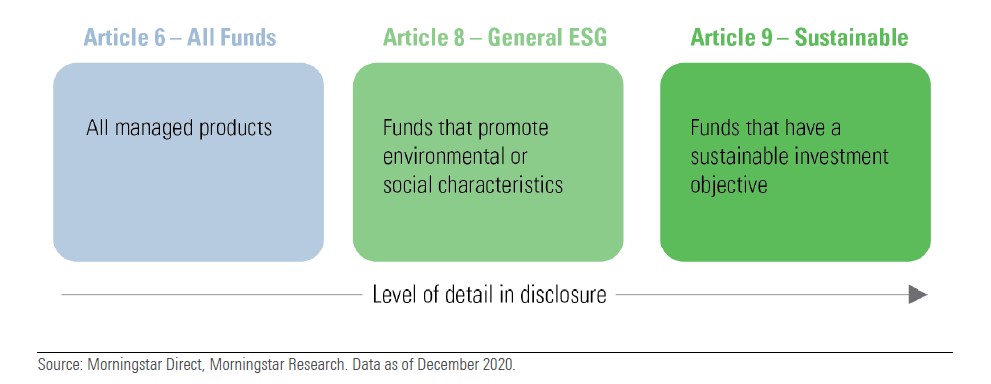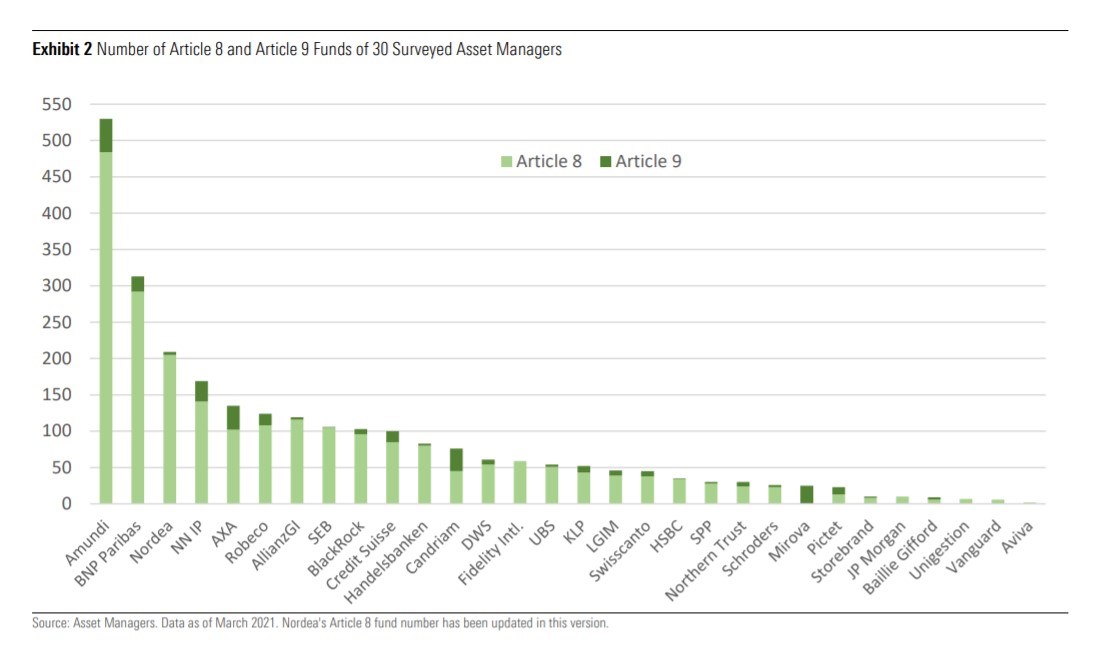
March 10 saw the EU Sustainable Finance Disclosures Regulation (SFDR) take effect, requiring fund companies to classify each of their funds into one of three categories: Article 6, 8, or 9, depending on the strategy’s objective.
The less-than-catchy category titles are derived from the legislations. All funds are now required to provide some ESG disclosure (as per Article 6), while Article 8 (or light green) and Article 9 (dark green) funds will be required to provide more detailed ESG information to investors.

The European Sustainable Fund Market Could Be Worth €2.5 Trillion
Although the investment industry is still adjusting to the measures and uncertainties remain about Article 8 and Article 9 classification, Morningstar has started collecting this data from fund prospectuses. Based on preliminary data (11,500 open-end funds and exchange-traded funds domiciled in Luxembourg), we estimate that funds classified as Article 8 and 9 currently represent up to 21% of total European funds and up to 25% of total European fund assets.
Of thesel, 18% were classified as Article 8 and 3.6% as Article 9. The European ESG and sustainable fund market, based on SFDR definitions, could therefore currently be worth as much as €2.5 trillion.
A Look at the Funds
Morningstar Research has also surveyed a sample of 30 asset managers of various nationalities and sizes, ranging from large European and US firms such as Amundi, UBS, BlackRock, and JPMorgan to boutique and sustainability-focused firms such as Candriam and Mirova.
We found that French managers Amundi and BNP Paribas offer some of the largest ranges of investment products classified as Article 8 or 9, with 529 and 310 funds respectively. Other groups have chosen to classify far fewer funds as Article 8 or 9. BlackRock, for example, has 103 classified products and UBS and JPMorgan have classified 54 and 10 of their funds respectively as Article 8 or 9 products.

On an asset-relative basis, Nordic and Dutch firms feature among those with the highest proportion of fund assets in Article 8 and 9. For example, Robeco has classified 96% of its fund assets as Article 8 or 9, while KLP and SEB have 95% and 82% of their fund assets respectively in the two categories. Sustainability-focused boutique Mirova has positioned its full range of 25 funds in the Article 9 category.
“For many of the asset managers we spoke to, it is essential to have as many funds as possible classified under Article 8 and 9. They see SFDR as an opportunity to demonstrate their commitment to sustainable investing,” says Hortense Bioy, Morningstar's global director of sustainability research. “They also feel pressure from some distributors and fund buyers that have said they would only consider funds in Article 8 and 9 categories going forward."
Looking at how funds have been classified so far, we can see a variety of approaches, with some asset managers saying they preferred to take a conservative approach for fear of having to downgrade funds later, notes Bioy: "Asset managers have categorised their products based on their understanding of the regulator's definitions, which thus far has resulted in a wide range of investment products classified as Article 8 and 9”. Certainly, further guidance from the regulator will help to create a more homogeneous picture in the future.










:quality(80)/cloudfront-us-east-1.images.arcpublishing.com/morningstar/6BCTH5O2DVGYHBA4UDPCFNXA7M.png)

















